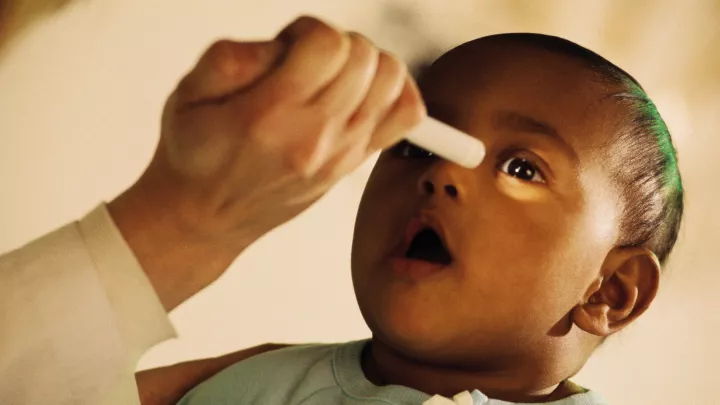Eye Surgery
Pediatric eye surgery is complex, often involving multiple conditions and areas of the eye. The eye surgeons at Children’s Hospital Los Angeles understand the challenges of operating on the eye and how surgery may improve your child’s life and vision in the long term.
Our surgeons take a personalized approach, prioritizing safety and using innovative techniques. When treatment involves many areas of the eye, our specialists collaborate. They operate under the same umbrella, coordinating treatments to keep your child’s time under anesthesia to a minimum.
We have a full suite of diagnostic equipment in our operating rooms. We obtain the images we need while your child is asleep for surgery.
Types of Pediatric Eye Surgery
Our ophthalmologists will always explore nonsurgical eye treatment options first. But when a child needs surgery, our experts perform all types of operations, including:
Cataract surgery
A cataract is the clouding of an eye’s naturally clear lens. As a result, your child may have vision that is blurry, hazy or dull. Cataracts typically affect adults, but children may be born with a cataract or develop one due to a genetic condition or in response to an injury. If your child’s cataract interferes with their vision development, surgery to remove the cloudy lens may be necessary.
The purpose of the eye’s lens is to help with focus. After lens removal, most children and adults can have an artificial lens implanted. Depending on the age and situation, a synthetic lens may not be implanted when the cataract is removed. When that happens, strong glasses or contact lenses may be needed to improve their eyesight. In some cases, a special lens called the Artisan can be considered. CHLA is one of the few centers in the world certified to implant these in babies and children.
Corneal transplant (keratoplasty)
The cornea is the clear, outer layer of the eye. When it is damaged—due to eye disease or injury—it can change shape or be hard to see through, distorting your child’s vision.
Our expert surgeons can perform a cornea transplant to replace part or all your child’s cornea. The surgery is done under general anesthesia and most children go home the same day.
Glaucoma surgery
Glaucoma is a condition that occurs when a child is born with or develops a dysfunctional drainage system in their eye. Without proper drainage, fluid buildup causes high eye pressure. This high pressure may damage the optic nerve—which transmits images to the brain—and cause permanent vision loss.
Surgery can correct structural defects, increase fluid drainage and decrease the eye’s pressure.
Our surgical treatment options for glaucoma include:
- Micro (filtering) surgery: Using fiberoptic technology, the surgeon creates a new drainage system within the eye.
- Laser surgery: A powerful, directed beam of light decreases the fluid produced by the eye, thereby decreasing the eye pressure.
- Glaucoma implants: When small incision surgery is not an option, surgeons can place one or more implants that drain fluid from the eye to decrease the eye pressure. These implants may remain in place for life.
Surgery for retinal diseases
The retina is the layer of tissue at the back of your eye. It senses light and converts it into the electric impulses used by the brain to form images. If the retina becomes inflamed, injured, torn or detached, it can’t function as it should and needs to be repaired. Many retinal issues in children stem from retinal detachments or inherited retinal diseases.
Our Retina Program surgeons may perform your child’s retinal procedure using a microscopic endoscope inserted through a small incision in the side of your child’s eye. An endoscope allows surgeons to clearly see the retina and the back of the eye during surgery in cases where it would otherwise be difficult.
Our surgical treatments for retinal diseases include:
Vitrectomy
Ophthalmologists perform this operation to remove the eye’s vitreous gel—a jelly-like substance in the center of the eye. Removing the vitreous gel gives the surgeon better access to the retina to make repairs. Surgeons often perform a vitrectomy along with other retinal surgeries.
Retinal detachment surgery (scleral buckle)
If your child’s retina detaches, a scleral buckle procedure can help secure the retina. During the operation, the surgeon sews a flexible silicone band around the eye to hold the retina in place. Scleral buckle surgery is often performed with vitrectomy.
Enucleation (eye removal surgery)
Surgery is rarely needed to treat retinoblastoma—cancer that forms in the retina. But if your child has advanced cancer or complete loss of vision, the ophthalmologist may recommend enucleation (surgical removal of the eye and optic nerve).
During the surgery, the eyeball is replaced with an orbital implant and is attached to the eye muscles to provide movement. Later, the implant is covered with a shell that matches your child’s remaining eye, making the artificial eye less noticeable.
Eye gene therapy surgery
Our specialists use eye gene therapy to treat patients with hereditary retinal disease and an RPE65 mutation. Surgeons add a functioning gene to each eye to replace the faulty gene. It entails two procedures—one for each eye—performed about a week apart.
Strabismus surgery (eye muscle surgery)
Strabismus is an eye movement disorder in which the eyes are misaligned (crossed) and don’t look in the same direction. It happens when the muscles that control eye movement aren’t functioning correctly.
Surgeons can fix strabismus by adjusting the eye muscles. They cut the muscle from the surface of the eye and reattach it in a new location to either increase or decrease the muscle tension. Strabismus surgery is often used in combination with glasses and other nonsurgical treatments.
Surgical Expertise for Every Pediatric Eye Condition
Our skilled pediatric eye specialists have experience treating every area of the eye. Meet our team.
Contact us
To schedule an appointment at the Vision Center, call 323-361-2347.


